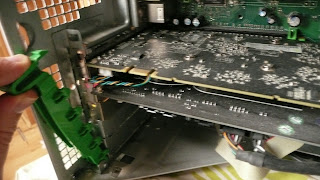Since I upgraded to my new editing station, I've had less call to use my older machine, a Dell Dimension 8400 which is over seven years old. However, the Dimension runs all my old 32bit XP software, including After Effects which won't transfer over to my new Windows Vista 64bit machine.
Recently the old Dell started playing up, displaying CMOS warning messages on startup and generally being a bit flaky. It turned out that the Bios battery was nearly dead, unsurprising given the age of the machine.
Changing the Bios battery in one of these old Dells is a very straightforward job, so easy that even a computer illiterate like me can do it. First I downloaded the user manual from the Dell support website http://support.dell.com/support/edocs/systems/dim8400/en/index.htm which helped to identify the parts needed.
The Dell uses a very common type of battery, a CR2032, and I already had some on hand, so all I had to do was open up the case and get to work. These batteries are available from ebay or your local Radio Shack, and should only cost one or two pounds.
First of all disconnect the power and remove all the cables. The case opens on a hinge at the front, so simply press the large button on the top rear of the case and push the case open.
Inside, the CMOS battery is hidden behind the graphics card and other boards on the lower left of the picture.
Here's a close up of the battery, the graphics card is blocking access and will need to be removed.
Once again, a very simple task on these new Dells, what would once have meant unscrewing the tiny connectors on each board is now simply a case of unclipping the green plastic bar at the outer end of the boards.
With the bar removed, the Graphics card and other cards slide out with only a little pressure. They are fixed at the back by small connecting lugs, so tilt the out at an angle. Be sure to avoid touching the metal ontacts on the boards and beware of static charges... be sure to ground yourself before touching the boards otherwise you could damage them.
Now the CMOS Bios battery is clearly revealed. I used a wooden pick to spring the clip holding the battery in place and it popped out.
A quick press with the finger and the new battery is in place and the machine is ready to go.
After re-connecting all the cables, the machine boots up and a quick press of F2 enters the Bios menu. I needed to disable the floppy drive as my machine doesn't have one, and then I set the date and time.
That's it, the machine is ready to go, and all set to give a few more years of After Effects and Photoshop work to my projects.
Saturday 21 January 2012
Herding words again...

It's four months since I finished my 'Bourne' style short, and I've found myself mired in devlopment on my next projects. Partly because I have
I'm keen to crack on and shoot something longer, with the goal being feature length, and I have two different ideas for genre films that would be suitable for the niche-channels like syfy or horror. Provided they don't go out of business with the recession of course! I have two different scripts I am developing towards that goal, but they still require a great deal of work to get beyond the first-draft stage.
Jumping straight into a feature length would be a big risk, especially as I also need to develop my interior lighting skills, so it makes sense to try a smaller project that uses lights.
I also need to prove my pipeline for audio recording. I wasn't happy with the results from my DAT walkman on the 'bourne' short, and I have upgraded to a digital recorder which I need to test properly.
So, I intend to make at least another two short films this year, and I have been working on the script and planning for the first of these, for which I will be concentrating on interior lighting and shooting multi-camera dialogue.
Project Tacoma
This will be a slightly longer film than my last one, the script for Tacoma is running to ten pages, with a lot of talking, and at least one simple vfx sequence to add a bit of intertest.
The goal is to shoot within the next two months, so I need to get my skates on, otherwise spring will arrive and I will lose the dark and overcast weather that I want.
Project Lotide
The second short film for this year will have a different purpose.
If I were to set one goal for myself with a short film, it would certainly be to try and win best short in at least one competition.
I feel like I can achieve the visual quality I need, but the missing piece is the content. Festival winners seem to fall into a very different catagory from the kind of films I usually make, winning festival films generally get by with less ninjas, hitmen and zombies that my projects.
So I've also been putting some thought into what kind of short would be best suited to festivals, I tend towards the more commercial end of things when I come up with an idea, but clearly a more arthouse sensibility would be better for the film festival market.
I think I have a good idea for this project and Lotide will be quite different from the kind of films I have made before, not least of all because it will feature only a single line of dialogue.
I will update on both of these projects as they develop.
Labels:
development,
film festival,
script revisions,
short film
Subscribe to:
Posts (Atom)








